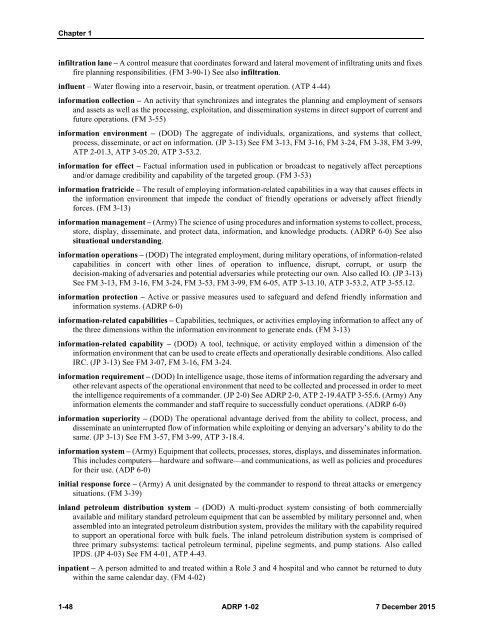ADRP1-02
52543f77c16bcfa46f6e1de2B038ef195
52543f77c16bcfa46f6e1de2B038ef195
Create successful ePaper yourself
Turn your PDF publications into a flip-book with our unique Google optimized e-Paper software.
Chapter 1<br />
infiltration lane – A control measure that coordinates forward and lateral movement of infiltrating units and fixes<br />
fire planning responsibilities. (FM 3-90-1) See also infiltration.<br />
influent – Water flowing into a reservoir, basin, or treatment operation. (ATP 4-44)<br />
information collection – An activity that synchronizes and integrates the planning and employment of sensors<br />
and assets as well as the processing, exploitation, and dissemination systems in direct support of current and<br />
future operations. (FM 3-55)<br />
information environment – (DOD) The aggregate of individuals, organizations, and systems that collect,<br />
process, disseminate, or act on information. (JP 3-13) See FM 3-13, FM 3-16, FM 3-24, FM 3-38, FM 3-99,<br />
ATP 2-01.3, ATP 3-05.20, ATP 3-53.2.<br />
information for effect – Factual information used in publication or broadcast to negatively affect perceptions<br />
and/or damage credibility and capability of the targeted group. (FM 3-53)<br />
information fratricide – The result of employing information-related capabilities in a way that causes effects in<br />
the information environment that impede the conduct of friendly operations or adversely affect friendly<br />
forces. (FM 3-13)<br />
information management – (Army) The science of using procedures and information systems to collect, process,<br />
store, display, disseminate, and protect data, information, and knowledge products. (ADRP 6-0) See also<br />
situational understanding.<br />
information operations – (DOD) The integrated employment, during military operations, of information-related<br />
capabilities in concert with other lines of operation to influence, disrupt, corrupt, or usurp the<br />
decision-making of adversaries and potential adversaries while protecting our own. Also called IO. (JP 3-13)<br />
See FM 3-13, FM 3-16, FM 3-24, FM 3-53, FM 3-99, FM 6-05, ATP 3-13.10, ATP 3-53.2, ATP 3-55.12.<br />
information protection – Active or passive measures used to safeguard and defend friendly information and<br />
information systems. (ADRP 6-0)<br />
information-related capabilities – Capabilities, techniques, or activities employing information to affect any of<br />
the three dimensions within the information environment to generate ends. (FM 3-13)<br />
information-related capability – (DOD) A tool, technique, or activity employed within a dimension of the<br />
information environment that can be used to create effects and operationally desirable conditions. Also called<br />
IRC. (JP 3-13) See FM 3-07, FM 3-16, FM 3-24.<br />
information requirement – (DOD) In intelligence usage, those items of information regarding the adversary and<br />
other relevant aspects of the operational environment that need to be collected and processed in order to meet<br />
the intelligence requirements of a commander. (JP 2-0) See ADRP 2-0, ATP 2-19.4ATP 3-55.6. (Army) Any<br />
information elements the commander and staff require to successfully conduct operations. (ADRP 6-0)<br />
information superiority – (DOD) The operational advantage derived from the ability to collect, process, and<br />
disseminate an uninterrupted flow of information while exploiting or denying an adversary’s ability to do the<br />
same. (JP 3-13) See FM 3-57, FM 3-99, ATP 3-18.4.<br />
information system – (Army) Equipment that collects, processes, stores, displays, and disseminates information.<br />
This includes computers—hardware and software—and communications, as well as policies and procedures<br />
for their use. (ADP 6-0)<br />
initial response force – (Army) A unit designated by the commander to respond to threat attacks or emergency<br />
situations. (FM 3-39)<br />
inland petroleum distribution system – (DOD) A multi-product system consisting of both commercially<br />
available and military standard petroleum equipment that can be assembled by military personnel and, when<br />
assembled into an integrated petroleum distribution system, provides the military with the capability required<br />
to support an operational force with bulk fuels. The inland petroleum distribution system is comprised of<br />
three primary subsystems: tactical petroleum terminal, pipeline segments, and pump stations. Also called<br />
IPDS. (JP 4-03) See FM 4-01, ATP 4-43.<br />
inpatient – A person admitted to and treated within a Role 3 and 4 hospital and who cannot be returned to duty<br />
within the same calendar day. (FM 4-<strong>02</strong>)<br />
1-48 ADRP 1-<strong>02</strong> 7 December 2015


